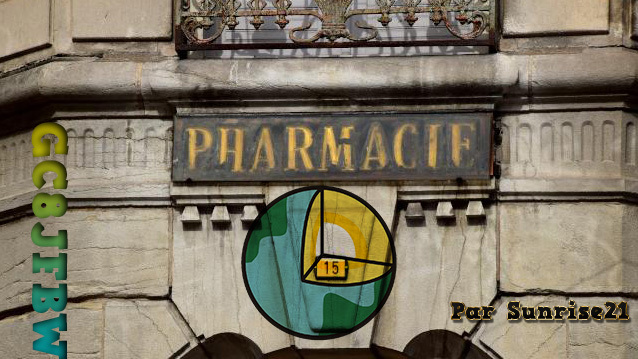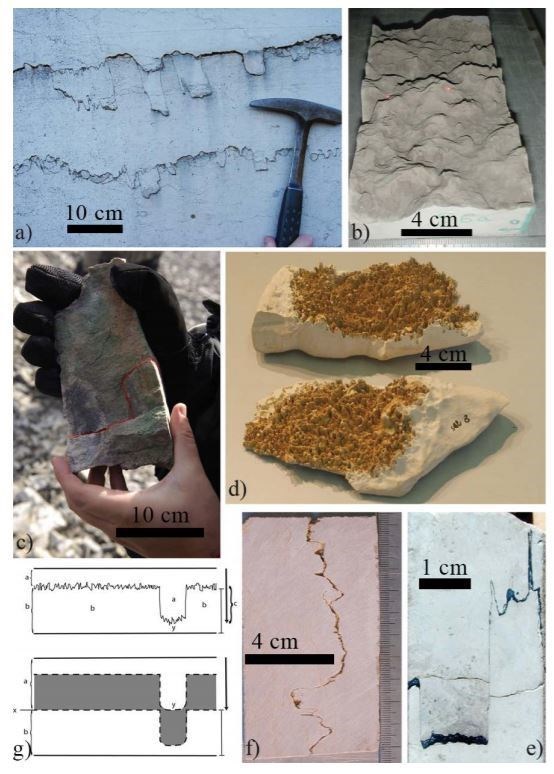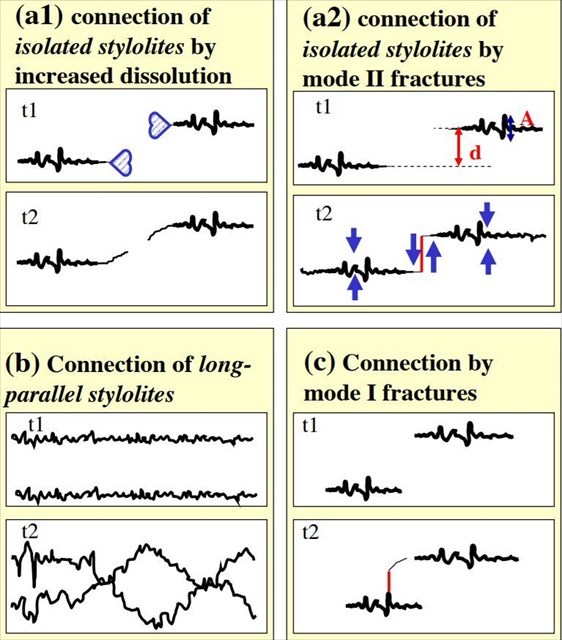Stress à l'Ancienne Pharmacie ( Luzy )

Le terme stylolite - une combinaison des mots grecs anciens stylos (pilier) et lithos (pierre) - a été inventé au 19e siècle pour désigner à l'observation que ces motifs peuvent présenter des formes en colonnes.
Les stylolites sont des interfaces entrelacées dans les roches naturelles qui se forment par un processus de dissolution localisée. Plus globalement, elle s’inscrit dans un mouvement de «pression - dissolution» qui réduit le volume de la roche.
Les articulations stylolitiques sont faites de cônes ressemblant à des dents. Les axes des cônes pointent toujours dans la direction du stress maximum au moment de leur formation. Elles sont souvent plus foncées que leurs roches hôtes: des particules insolubles enrobées de fer s'accumulent dans le joint.

Variété de motifs stylolites. a-b) Stylolites colonnaires et rugueuses dans les calcaires (Bourgogne, France). c) Stylolite colonnaire dans une dolomie (baie de Murchinson, Spitzberg). le stylolite est souligné en rouge. d) Vue tridimensionnelle d'une stylolite dans un calcaire (Vercors,France). e) Stylolite colonnaire avec concentration d'argiles en haut et en bas des dents(Grèce) f) Stylolite colonnaire en calcaire où la plupart des dents ont été dissoutes (Vercors,France). g) Première interprétation de la formation de stylolites par dissolution le long d'une interface, et que la longueur des colonnes représente un minimum pour l'épaisseur de la roche dissoute.
Schema montrant plusieurs possibles mécanismes pour la formation de réseaux stylolites interconnectés de temps t1 à t2

(a) Connexion de stylolites isolées :
(a1) connexion de stylolites isolés par dissolution accrue
(a2) connexion de stylolites isolés par fractures de mode II
Une augmentation du stress normal (dans les régions en forme de cœur bleu) améliore la dissolution et peut changer la direction de propagation (a1), alors qu'une augmentation de la contrainte de cisaillement peut provoquer une fracturation (a2). Cela dépend de la propriété mécanique de la roche à ce temps. A et d (a2) déterminent la connexion par liaison ou fracturation. Les flèches bleues (a2) indiquent la direction du stress.
b) Connexion de stylolites à long parallèle par leur dissolution et leur rugosité («Cannibalisme» de stylolites parallèles longues et espacées).
(c) Connexion des stylolites via le mode I fractures, émanant de dents de stylolite.
De telles fractures peuvent relier les stylolites selon les deux modèles (a) et (b)(Connexion de stylolites simples ou dissolution continue du parallèle stylolites). Les pointes d'une stylolite adjacente peuvent se courber en formant une veine, ce qui traduit une tension importante.
Stress at the Old Pharmacy (Luzy)

The term stylolite - a combination of the ancient Greek words pens (pillar) and lithos (stone) - was coined in the 19th century to refer to the observation that these patterns can have columnar shapes.
Stylolites are intertwined interfaces in natural rocks that form through a process of localized dissolution. More generally, it is part of a movement of "pressure - dissolution" which reduces the volume of the rock.
The stylolitic joints are made of cones resembling teeth. The axes of the cones can be perpendicular to the joint or to an angle, but they always point in the direction of maximum stress at the time of their formation.
Stylolitic joints are often darker than their host rocks: insoluble iron-coated particles accumulate in the joint.

Variety of stylolite patterns. a-b) Columnar and rough stylolites in limestones (Burgundy, France). c) Columnar stylolite in a dolomite (Murchinson Bay, Spitsbergen). the stylolite is underlined in red. d) Three-dimensional view of a stylolite in a limestone (Vercors, France). e) Columnar stylolite with concentration of clays at the top and bottom of the teeth (Greece) f) Columnar stylolite in limestone where most of the teeth were dissolved (Vercors, France). g) First interpretation of the formation of stylolites by dissolution along an interface, and that the length of the columns represents a minimum for the thickness of the dissolved rock.
Cartoon showing several possible mechanisms for the formation of interconnected stylolite networks from time t1 to t2.

(a) Connection of isolated stylolites.
(a1) connection of isolated stylolites by increased dissolution
(a2) connection of isolated stylolites by mode II fractures
An increase in normal stress (in blue heart-shaped regions) improves dissolution and can change the direction of propagation (a1), while an increase in shear stress can cause fracturing (a2). It depends on the mechanical property of the rock at this time. A and d (a2) control the weather connection or bonding. The blue arrows (a2) indicate the direction of stress
b) Connection of long parallel stylolites by their dissolution and their roughness ("Cannibalism" of long and spaced parallel stylolites).
(c) Connection of stylolites via mode I fractures, emanating from stylolite teeth.
Such fractures can connect the stylolites according to the two models (a) and (b) (Connection of simple stylolites or continuous dissolution of the parallel stylolites). Spikes of an adjacent stylolite can bend towards such a vein, which induces significant tension.
|
Sources :
https://inis.iaea.org/collection/NCLCollectionStore/_Public/45/085/45085965.pdf
http://stylolite.free.fr/stylolites.html
http://homepage.ufp.pt/biblioteca/Thesaurus%20Illustre%20de%20Stratigraphie%20Sequentielle%20et%20Termes%20Associes/Pages/PageS1.html#Styolitisation
http://www.geosci.usyd.edu.au/users/prey/Patrice_Intro_to_SG.pdf
|
Rappel concernant les « Earthcaches »: Il n'y a pas de conteneur à rechercher ni de logbook à renseigner. Il suffit de se rendre sur les lieux et d'éxécuter les requêtes du géocacheur.
Loguez cette cache "Found it" et envoyez-moi vos propositions de réponses soit via mon profil, soit via la messagerie geocaching.com (Message Center), EN PRECISANT LE NOM ET CODE GC DE LA CACHE et je vous contacterai en cas de problème.
Il est aussi apprécié d'avoir des photos des géocacheurs sur les lieux de l''EarthCache. Sentez-vous inspiré de poster des photos de vous lors de cette visite
---
Reminder concerning "Earthcaches": there is neither a container to look for nor a logbook to sign.
Log in this cache " Found it " and send me your answers proposals or via my profile or via geocaching.com messaging (Message Center ) , BY PROVIDING THE NAME AND GC CODE OF THE CACHE and I will contact you in case of problems .
We also enjoy seeing photographs of people visiting this EarthCache. Please feel free to log photos of your visit...
Grâce à la lecture du descriptif, les schemas, et votre observation, répondez aux questions suivantes :
Thanks to the reading of the description, cartoons and your observation, answer the following questions:
Q1 Entre A et B, quel bloc a subi le plus de stress ?
Q2 Ici, sur la zone C, quel mécanisme est en œuvre et à quel temps correspond il ?
Q3 Toujours sous la zone C, decrivez la couleur de la roche au contact des stylolites.
Q4 Ici, sur la zone D, quel mécanisme est en œuvre et à quel temps correspond il ?
Q5 Ici, sur la zone E, quel mécanisme est en œuvre ?
Q1 Between A and B, which block experienced the most stress?
Q2 Here, in zone C, what mechanism is in use and what time corresponds to it?
Q3 Also with the C area, sescribe the color of the rock in contact with the stylolits
Q3 Here, in area D, what mechanism is in use and what time does it correspond to?
Q4 Here, in zone E, which mechanism is used ?
JOYEUX & HAPPY EARTHCACHING !